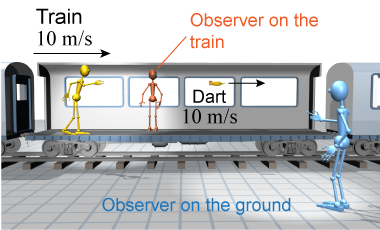|
 Consider the questions on the right. These are not trivial questions. More than 2,000 years of thinking by many very smart people was necessary to come up with answers that are satisfactory.
Consider the questions on the right. These are not trivial questions. More than 2,000 years of thinking by many very smart people was necessary to come up with answers that are satisfactory. 
|
 To illustrate the point, imagine a person on a train throwing a dart at a speed of 10 m/s. The train car the person is in is moving forward at 10 m/s. What is the speed of the dart? An observer on the train measures the speed to be 10 m/s. An observer on the ground, however, measures the speed to be 20 m/s. Who is correct?
To illustrate the point, imagine a person on a train throwing a dart at a speed of 10 m/s. The train car the person is in is moving forward at 10 m/s. What is the speed of the dart? An observer on the train measures the speed to be 10 m/s. An observer on the ground, however, measures the speed to be 20 m/s. Who is correct? 
|
Both are correct because there is no absolute “zero” velocity! Whether an object is at rest or in motion depends entirely on your reference frame. Think of a reference frame as an imaginary “box” that you consider to be “at rest” for the purpose of making measurements. Velocities are measured with respect to your reference frame. The observer on the train might choose the inside of the train car to be the reference frame. In that reference frame the speed of the dart is 10 m/s. The observer outside might choose the ground to be the reference frame. In this reference frame the speed of the dart is 20 m/s. 
|

|
The velocity of a moving object in one reference frame is equal to the velocity in a second reference frame plus the velocity of the second reference frame relative to the first. If this sounds confusing, consider the ground as the first reference frame. The moving train is the second. The velocity of the dart with respect to the ground (20 m/s) is the velocity of the dart with respect to the train (10 m/s) plus the velocity of the train with respect to the ground (another 10 m/s). 
 |
The argument above is true for ordinary speeds far below the speed of light, which is 3×108 m/s. Light itself does not obey this common-sense rule. The speed of light is the same 3×108 m/s in all reference frames regardless of their relative velocities. That means the beam from a flashlight shining from a moving train has the same velocity in your reference frame independent of whether the train is moving toward you or away from you. Think about this! The only way it can be true is if somehow time and space are different to observers in reference frames in relative motion. That is the fundamental insight into the special theory of relativity that rocked the world when it was proposed in 1905 by the young Albert Einstein. 
|
An inertial reference frame is one in which the velocity is constant in both speed and direction. It was one of Einstein’s brilliant insights that no physical experiment can determine the velocity of an inertial reference frame without somehow looking “outside!” This means that, if the train car were on a smooth track moving at constant speed (with no windows), then nothing a physicist could do inside the car could determine its motion relative to any external reference frame. 
|

